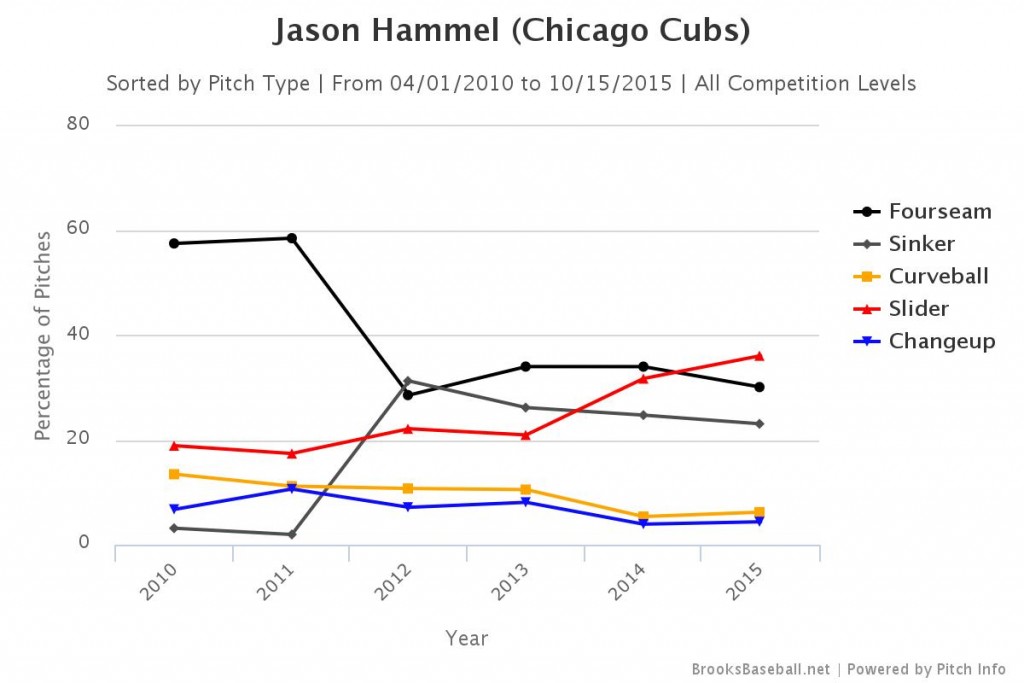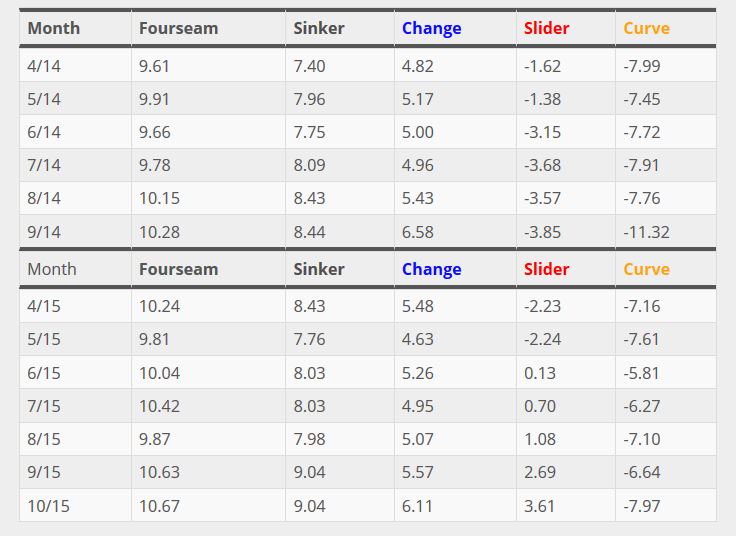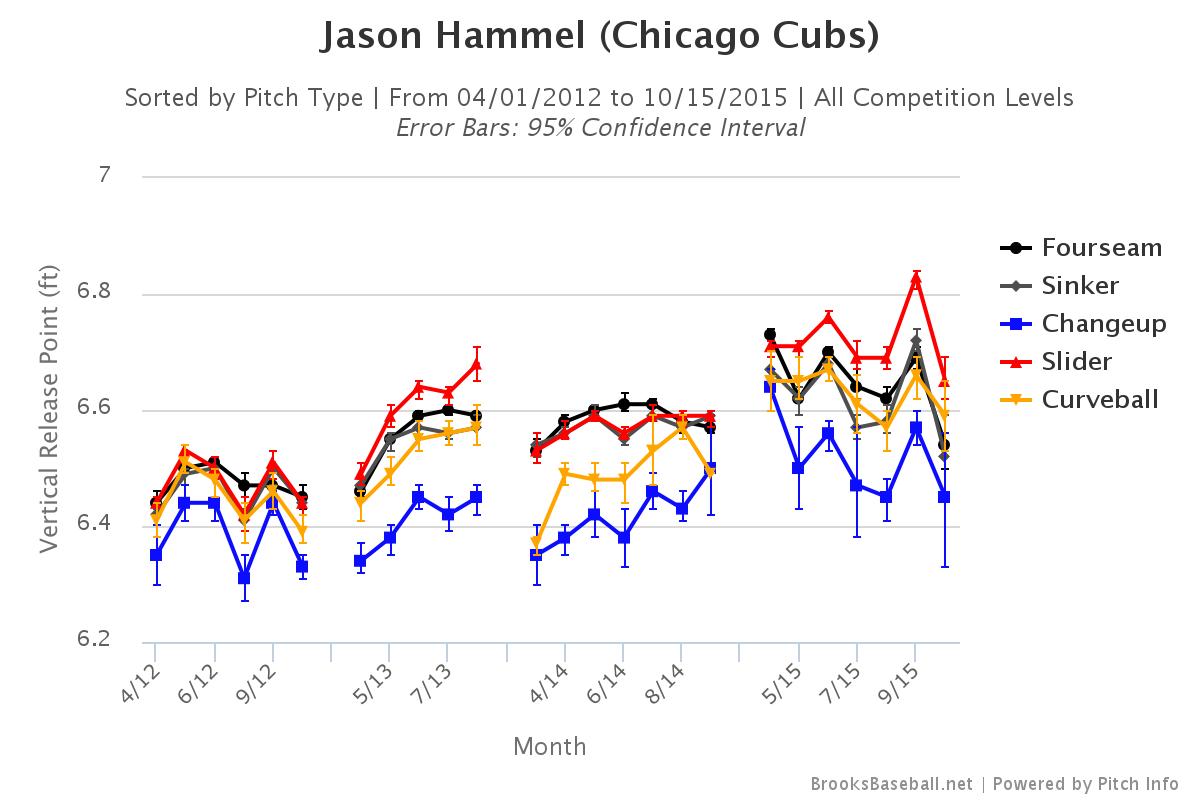After leaving New York in the worst-case scenario, the Cubs will turn to their offense and the shaky back-end of their rotation to dig them out of the 0-2 series hole with the Mets. Kyle Hendricks has been announced as the Game Three starter night in what will certainly be a pivotal game, determining whether the Cubs have a real chance at winning the series or if they’ll need a Red Sox-like miracle run.
But in needing a fourth starter for tomorrow, the Cubs seem set to roll with Jason Hammel. It’s possible they could start Jon Lester on three-days rest, but at this point I’m not sure that’s a great idea. Pushing up Lester pretty much requires pushing up Arrieta, and his last two games tell me he needs more rest, not less. And Lester has only worked on three days rest twice in his career, the last time being in 2011. So it’ll likely be Hammel on the mound with the Cubs looking to either even the series or extend their season.
Despite being left off the NLDS and NLCS a roster, I think it should have been Dan Haren instead of Hammel—which is much more about Hammel being bad than it is about Haren being good.
Hammel gave up two runs in game four of the NLDS before most of us could even get the TV or radio on, and it’s clear that Joe Maddon has a very quick hook with him—he pulled Hammel out of the game after walking Jhonny Peralta on four pitches leading off the fourth inning. Hammel threw just 49 pitches in the game, facing 14 batters, of which he struck out two, walked three, got one ground ball, three fly balls, and five line drives. I think we can clearly say he was lucky to only have surrendered the two runs.
It’s no secret that Hammel has struggled heavily in the second half after starting the season well, but few have truly been able to put their finger on what exactly is different. His pitch location just doesn’t look right, but the velocity is there. His fastball averaged 92.96 mph this season compared to 93.47 mph last season, which is a negligible difference of 0.51 mph.
The real problem is his slider, which is his “out pitch” and, for the first time in his career, the most frequently used pitch in his arsenal.
Over 36 percent of his pitches in 2015 were sliders as opposed to around 30 percent fastballs. The slider usage was extremely heavy in the middle months, spiking at 41 percent in June. There have been no definitive studies on whether throwing too many sliders can damage a pitcher’s arm or disrupt his effectiveness, but a few years ago FanGraphs did a look at injuries among slider-heavy pitchers and how slider usage may have killed Brett Anderson’s elbow.
The results of Hammel over-using his slider have been ugly. There has been a noticeable change in the vertical movement on his slider in the last few months, in comparison to what it was earlier in the season and in 2014:
It’s important to note that whether he has positive or negative vertical movement on his slider really doesn’t matter. Each pitcher is different in the kind of response they get when they throw a slider and the type of movement it creates; some break toward right-handed batters and some break away, some have a tight spin and some have no spin at all. What matters here is the drastic change that Hammel has had in the break on his slider, going from being pretty consistently around -2 inches of movement to anywhere from zero to four inches.
This all started on May 24th in a game against the Diamondbacks in which Hammel threw sliders for 56 of his 105 pitches. After seven consecutive starts with a vertical movement of -2 inches or lower, he averaged only -0.88 inches in that game. The number rose from there, hitting a peak of 4.19 inches on September 15th against the Pirates.
Prior to that start on May 24th, hitters were smacking line drives off Hammel’s slider about 23.8 percent of the time. Since that time, the line drive rate has risen to 27.6 percent, which is about a 14 percent rise in line drives. I decided that I needed to look at some of his core stats to see if this change in vertical movement coincided with anything tangible, and the difference is clear.
So what might be causing this, you might ask? Well, it could have something to do with his vertical release point on his pitches. Back in 2012, Hammel reinvented himself as a starter when he signed with the Baltimore Orioles, beginning to throw less four-seam fastballs and more sliders and sinkers. He had the best season of his career (to that point) that year and, after a poor 2013, he signed with the Cubs and had another excellent season in 2014. With that in mind, let’s look at a chart that shows his vertical release point over those four seasons:
In general, slight changes in mechanics from year to year aren’t concerning. But the change in release point on his slider—and all of his pitches, really—on a month-to-month basis in 2015 screams of a pitcher who is searching for the right spot but can’t seem to make it work. In his previous seasons, the release point on his four-seem fastball, sinker, and slider are all pretty much the same. The difference in where his slider is released as opposed to the other two—even if it’s only an inch or two—could even lend to the notion that hitters have a better idea when the slider is coming, making it easier for them to square up (hence the higher line drive rate).
All of this brings me to my conclusion that Haren, who is retiring when the season ends, should have been the choice to start game four at Wrigley Field versus the Mets. It’s not as exhaustive of an analysis as digging into movement, usage, and release point of his pitches, but Haren was really good down the stretch. From September 1st through the end of the year—a span of six starts—Haren gave the Cubs 32 2/3 innings, allowing 27 hits and just seven walks with a 2.20 ERA.
This isn’t to say that I think Hammel shouldn’t be on the roster at all. With the injury to Addison Russell opening the door to possibly adding another pitcher to the roster instead of the speedy but one-dimensional Quintin Berry, Hammel could have gone to the bullpen to wait for an emergency situation, such as a long extra-inning game or a poor performance from Hendricks or Haren that requires someone to come in and eat innings.
But that is the biggest role I could envision for Hammel, if I were Joe Maddon. Of course, I’m not Joe Maddon, and he has consistently shown that he knows way more about managing a team than I do. With that being said, the decision on whether to start Hammel or Haren is painfully obvious. With the season in the balanace, if it were up to me, Haren wouldn’t be retiring just yet.




